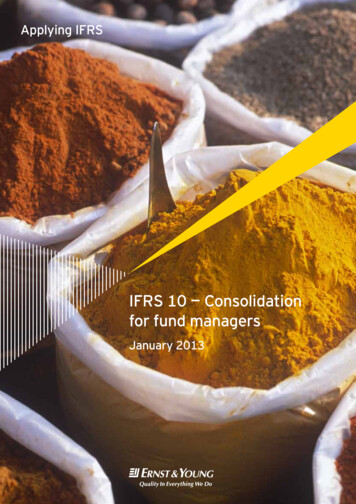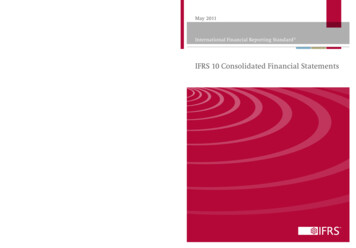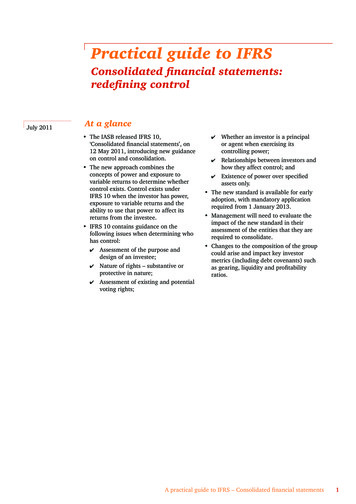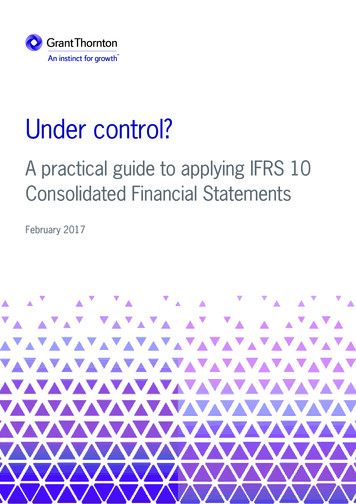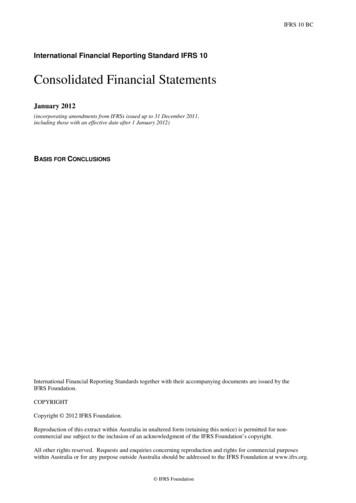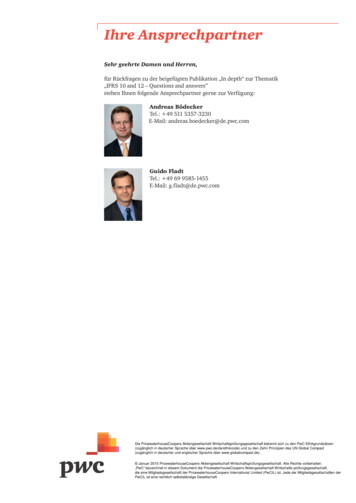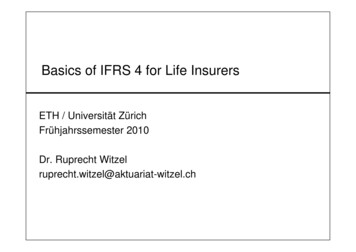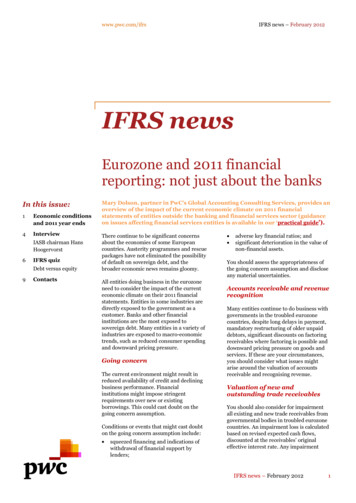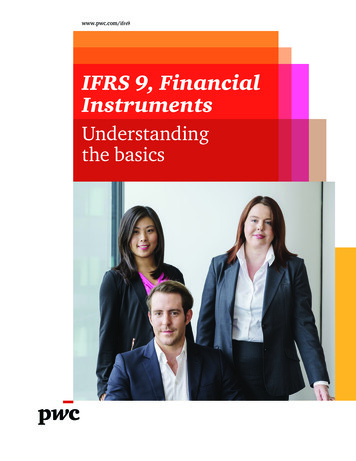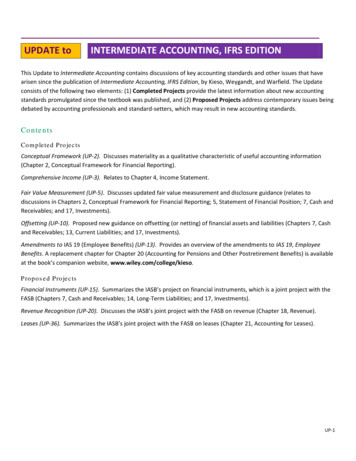
Transcription
IFRS 3 (Revised):Impact on earningsThe crucial Q&A for decision-makers
PricewaterhouseCoopers’ IFRS and corporate governance publications and tools 2008IFRS technical publicationsIFRS Manual of Accounting 2008Provides expert practical guidance on howgroups should prepare their consolidatedfinancial statements in accordance with IFRS.Comprehensive publication including hundredsof worked examples, extracts from companyreports and model financial statements.Adopting IFRS – A step-by-step illustration of thetransition to IFRSIllustrates the steps involved in preparing the first IFRSfinancial statements. It takes into account the effect onIFRS 1 of the standards issued up to and includingMarch 2004.Financial instruments under IFRSHigh-level summary of the revised financial instrumentsstandards issued in December 2003, updated to reflectIFRS 7 in September 2006. For existing IFRS preparersand first-time adopters.IFRS NewsMonthly newsletter focusing on the business implicationsof the IASB's proposals and new standards.IAS 39 – Achieving hedge accounting in practiceCovers in detail the practical issues in achieving hedgeaccounting under IAS 39. It provides answers to frequentlyasked questions and step-by-step illustrations of how toapply common hedging strategies.Illustrative condensed consolidated interim financialinformation – for existing preparersIllustrative information, prepared in accordance with IAS 34,for a fictional existing IFRS preparer.Includes a disclosure checklist and IAS 34 applicationguidance. Reflects standards issued up to 31 May 2006.Illustrative Consolidated Financial StatementsFinancial Reporting in Hyperinflationary Economies –Understanding IAS 292006 update (reflecting impact of IFRIC 7) of a guide forentities applying IAS 29. Provides an overview of thestandard’s concepts, descriptions of the procedures andan illustrative example of its application.IFRS 3R: Impact on earnings –the crucial Q&A for decision-makersGuide aimed at finance directors, financial controllers anddeal-makers, providing background to the standard, impacton the financial statements and business, and summarydifferences with US GAAP. Investment funds, 2006 Banking, 2006 Investment property, 2006 Corporate, 2007 Insurance, 2006Realistic sets of financial statements – for existing IFRSpreparers in the above sectors – illustrating the requireddisclosure and presentation.Illustrative Interim Consolidated Financial Statementsfor First-time Adopters – 2005Realistic set of interim IFRS financial statements for first-timeadopters. The financial statements for the six months endedJune 2005 illustrate the disclosure and presentation requiredby all IFRSs published up to and including December 2004.IFRS Disclosure checklist 2007Outlines the disclosures required by all IFRSs publishedup to September 2006.Share-based Payment –a practical guide to applying IFRS 2Assesses the impact of the new standard, looking at therequirements and providing a step-by-step illustration ofhow to account for share-based payment transactions.IFRS Measurement Checklist 2006Outlines the measurement bases required by all IFRSspublished up to September 2006.SIC-12 and FIN 46R – The Substance of ControlHelps those working with special purpose entities to identifythe differences between US GAAP and IFRS in this area,including examples of transactions and structures that maybe impacted by the guidance.IFRS for SMEs (proposals) – Pocket Guide 2007Provides a summary of the recognition and measurementrequirements in the proposed ‘IFRS for Small andMedium-Sized Entities’ published by the InternationalAccounting Standards Board in February 2007.Similarities and Differences –a comparison of IFRS and US GAAPPresents the key similarities and differences between IFRSand US GAAP, focusing on the differences commonly foundin practice. It takes into account all standards published upto August 2007.IFRS Pocket Guide 2006Provides a summary of the IFRS recognition andmeasurement requirements including currencies, assets,liabilities, equity, income, expenses, businesscombinations and interim financial statements.Understanding financial instruments –A guide to IAS 32, IAS 39 and IFRS 7Comprehensive guidance on all aspects of the requirementsfor financial instruments accounting. Detailed explanationsillustrated through worked examples and extracts fromcompany reports.
ContentsExecutive summary3Questions and answers7Differences between IFRS and US GAAP19Business implications21
2IFRS 3 (Revised): Impact on earnings – the crucial Q&A for decision-makers
Executive summary
Executive summaryAcquisitions (M&A) represent a core growth strategy for many companies.Accounting considerations shouldn’t drive acquisition decisions, butaccounting can have a real impact on deal structures, on the planning andprocess that surround deals, and on communications with the marketplace.Accounting for acquisitions has changed again. The International AccountingStandards Board (IASB) released a revised standard on businesscombinations in January 2008, accompanied by a revised standard onconsolidated financial statements. The Financial Accounting Standards Board(FASB), the IASB’s US counterpart, has issued an almost identical standardon business combinations and a similar standard on consolidated financialstatements.Management that is charged with planning acquisitions or that overseesacquisition activity will want to understand the impact of the standards inareas such as deal structures, financial reporting and investor/analystcommunications. This publication explores the more significant provisions ofthe standards and their implications for transaction decision-makers.What are the main impacts? The new standards are expected to add toearnings volatility, making earnings harder to predict. The standards are alsolikely to: influence acquisition negotiations and deal structures in an effort tomitigate unwanted earnings impacts; potentially impact the scope and extent of due diligence and datagathering exercises prior to acquisition; require new policies and procedures to monitor and determine changes inthe fair value of some assets and liabilities; call for the early input of accountants and lawyers, and expand the call forvaluation expertise; and influence the ‘how, when and what’ of stakeholder communications.The table below sets out the potential impact for gains and losses on day 1,measurement of assets and liabilities in the acquisition balance sheet andincome statement volatility on day 2 and beyond.This publication aims to help dealmakers and preparers of financialstatements communicate the consequences of a business combination onthe current year’s financial statements and how a business combination mayaffect the future years’ earnings.4IFRS 3 (Revised): Impact on earnings – the crucial Q&A for decision-makers
Executive summary (continued)Impact on earnings atcombination dateShare options given to seller3Existing interest held in targetEarn-out paid in a fixed number ofequity shares3Full goodwillContingent liabilitiesSettlement of pre-existing relationships33333333Restructuring costs3Indemnity from sellerBuying or selling minority interestOngoing earningsimpact33Earn-out paid in cash or shares to afixed amountTransaction costsImpact on netassets/goodwill atcombination date333333X11Transactions with minority interests resulted in income statement effects under IAS 27, depending on an entity’s policy. There will be no effect onincome under IAS 27 (Revised).IFRS 3 (Revised): Impact on earnings – the crucial Q&A for decision-makers5
6IFRS 3 (Revised): Impact on earnings – the crucial Q&A for decision-makers
Questions and answers
Questions and answersScope and applicabilityThe business combinations standard represents some significant changes forIFRS but is less of a radical change than the comparable standard in US GAAP.IFRS 3 (Revised) is a further development of the acquisition model. The standardnow applies to more transactions, as combinations by contract alone andcombinations of mutual entities are brought into the scope of the standard.Common control transactions and the formation of joint ventures remain outsidethe scope of the standard. The definition of a business has been amendedslightly. It now states that the elements are ‘capable of being conducted’ ratherthan ‘are conducted and managed’ to generate a return. This change issupplemented by a significant expansion of the application guidance. This maybring more transactions into acquisition accounting. Acquisition date does notchange under IFRS; US GAAP will converge to the existing requirements of IFRS.1. When will the newstandard affect thefinancial statements?IFRS 3 (Revised) is applied prospectively to business combinations occurring inthe first accounting period beginning on or after 1 July 2009. It can be appliedearly but only to an accounting period beginning on or after 30 June 2007.IFRS 3 (Revised) and IAS 27 (Revised) are applied at the same time.Retrospective application to earlier business combinations is not permitted.As with other standards, IFRS 3 (Revised) and IAS 27 (Revised) cannot beapplied by entities within the European Union until they are endorsed.2. Has the scope of thestandard changed?Yes, it now includes combinations of mutuals and combinations by contract.This change in scope is not significant for many entities. High-profilecombinations of mutual entities are uncommon, and combinations bycontract (staplings) occur in Australia but are rarely seen elsewhere.3. What about commoncontrol transactions?Common control transactions remain outside the scope of the new standard.The IASB is starting a project on accounting for them, but a new standard isnot expected soon. Entities choose a policy for such transactions. The mostcommon are either applying IFRS 3 by analogy to other business combinationsor using predecessor values by analogy to US and other GAAPs with similarframeworks. Entities should continue to use their existing policy for businesscombinations under common control.ConsiderationConsideration is the amount paid for the acquired business. Some of the mostsignificant changes are found in this section of the revised standard. Individualchanges may increase or decrease the amount accounted for as consideration.These affect the amount of goodwill recognised and impact the post-acquisitionincome statement. Transaction costs no longer form a part of the acquisitionprice; they are expensed as incurred. Consideration now includes the fair value ofall interests that the acquirer may have held previously in the acquired business.This includes any interest in an associate or joint venture or other equity interestsof the acquired business. If the interests in the target were not held at fair value,they are re-measured to fair value through the income statement.8IFRS 3 (Revised): Impact on earnings – the crucial Q&A for decision-makers
Consideration (continued)The requirements for recognition of contingent consideration have also beenamended. Contingent consideration is now required to be recognised at fair valueeven if it is not deemed to be probable of payment at the date of the acquisition.All subsequent changes in debt contingent consideration are recognised in theincome statement, rather than against goodwill as today.4. The selling-shareholderswill receive some shareoptions. What effect willthis have?An acquirer may wish selling-shareholders to remain in the business asemployees. Their knowledge and contacts can help to ensure that the acquiredbusiness performs well.The terms of the options and employment conditions could impact the amountof purchase consideration and also the income statement after the businesscombination. Share options have a value. The relevant accounting question iswhether this value is recorded as part of the purchase consideration, or ascompensation for post-acquisition services provided by employees, or somecombination of the two. Is the acquirer paying shareholders in their capacity asshareholders or in their capacity as employees for services subsequent to thebusiness combination?How share options are accounted for depends on the conditions attached tothe award and also whether or not the options are replacing existing optionsheld by the employee in the acquired business. Options are likely to beconsideration for post-acquisition service where some of the payment isconditional on the shareholders remaining in employment after the transaction.In such circumstances, a charge is recorded in post-acquisition earnings foremployee services. These awards are made to secure and reward futureservices of employees rather than to acquire the existing business.5. Is it true that somebusiness combinationswill result in gains in theincome statement?Yes, it is. Any previous stake is seen as being ‘given up’ to acquire thebusiness. A gain or loss is recorded on its disposal. If the acquirer already heldan interest in the acquired entity before acquisition, the standard requires theexisting stake to be re-measured to fair value at the date of acquisition, takingany movement to the income statement (together with any gains previouslyrecorded in equity that relate to the existing stake). If the value of the stake hasincreased, there will be a gain to recognise in the income statement of theacquirer at the date of the business combination. A loss would only occur if theexisting interest has a book value in excess of the proportion of the fair value ofthe business obtained – and no impairment had been recorded previously. Thisloss situation is not expected to occur frequently.The standard also requires any gain on a ‘bargain purchase’ (negative goodwill)to be recorded in the income statement. This is not a change from previousrequirements.6. Some of the paymentsfor the business areearn-outs. How arethese accounted for?It is common for some of the consideration in a business c
income statement. Transaction costs no longer form a part of the acquisition price; they are expensed as incurred. Consideration now includes the fair value of all interests that the acquirer may have held previously in the acquired business. This includes any interest in an associate or joint venture or other equity interests of the acquired business. If the interests in the target were not held at fair value,
